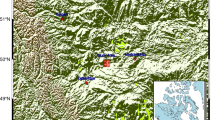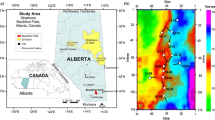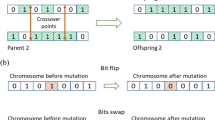Abstract
In this study, the focus is on predicting the properties of rocks beneath the Earth’s surface using global optimisation techniques such as genetic algorithms (GA), simulated annealing (SA) and particle swarm optimisation (PSO). The goal is to minimise the difference (error) between actual seismic data and synthetic (computed) seismic traces. Global optimisation is an approach that is independent of the initial model and aims to identify the global minimum of an objective function. In contrast, local optimisation relies on the accuracy of the initial model, and if an accurate initial model is not provided, it may become trapped in a local minimum, leading to an inaccurate representation of the subsurface model. What makes global optimisation powerful is that it does not get stuck in local minima (suboptimal solutions), but seeks the absolute best solution in the entire search space. This property is crucial in seismic inversion, where finding the most accurate representation of subsurface properties is of utmost importance for geophysical applications. The study includes one synthetic example and one real dataset, with a specific emphasis on evaluating acoustic impedance rock properties. While acoustic impedance is characteristic of rock layers, seismic data represents properties at the interfaces between these layers. Consequently, seismic data is highly valuable for gaining detailed insights into the subsurface. The results of the optimisation process provide exceptionally detailed views of the subsurface, aiding in the interpretation of seismic data. GA, SA and PSO algorithms perform well, both with synthetic data and real data. The inversion process identifies a zone with low acoustic impedance, corresponding to a prominent seismic anomaly. The evaluation of the inverted outcomes reveals that the impedance within the area ranges from 4300 to 4700 m/s*g/cc, situated within a specific time range of 900–950 ms in the seismic data of F3-block, Netherland.












Similar content being viewed by others
References
Bain J S 1993 Historical overview of exploration of tertiary plays in the UK North Sea; In: Petroleum geology of Northwest Europe, Proceedings of the 4th conference (ed.) J R Parker, Geol. Soc. London 4 5–14, https://doi.org/10.1144/0040005.
Brooks J and Glennie K W (eds) 1987 Petroleum Geology of North West Europe; Proceedings of the 3rd Conference on Petroleum Geology of North West Europe Held at the Barbican Centre, London, 26–29 October 1986.
Clochard V, Delépine N, Labat K and Ricarte P 2009 Poststack versus pre-stack stratigraphic inversion for CO2 monitoring purposes: A case study for the saline aquifer of the Sleipner field; SEG 24 17–21, https://doi.org/10.1190/1.3255345.
Downton J E 2005 Seismic parameter estimation from AVO inversion; PhD Thesis, University of Calgary, Alberta.
Kant R, Maurya S P and Singh K H 2023 Qualitative and quantitative reservoir characterisation using seismic inversion based on particle swarm optimisation and genetic algorithm: A comparative case study, https://doi.org/10.21203/rs.3.rs-3141822/v1.
Kennedy J 2003 Bare bones particle swarms; In: Proceedings of the 2003 IEEE Swarm Intelligence Symposium; IEEE 80–87, https://doi.org/10.1109/SIS.2003.1202251.
Krebs J R, Anderson J E, Hinkley D, Neelamani R, Lee S, Baumstein A and M D 2009 Fast full-wave field seismic inversion using encoded sources; Geophysics 74(6), https://doi.org/10.1190/1.3230502.
Kushwaha P K, Maurya S P, Rai P and Singh N P 2021 Estimation of subsurface rock properties from seismic inversion and geo-statistical methods over F3-block, Netherland; Explor. Geophys. 52(3) 258–272, https://doi.org/10.1080/08123985.2020.1815528.
Lindseth R O 1979 Synthetic sonic logs – a process for stratigraphic interpretation; Geophysics 44(1) 3–26, https://doi.org/10.1190/1.1440922.
Margrave G F, Lawton D C and Stewart R R 1998 Interpreting channel sands with 3C-3D seismic data; Lead. Edge 17(4) 509–513.
Maurya S P and Singh K H 2015 Reservoir characterisation using model-based inversion and probabilistic neural network; Discovery 49(228) 122–127.
Maurya S P and Singh K H 2017 Band limited impedance inversion of Blackfoot Field, Alberta, Canada; J. Geophys. 38(1) 57–61.
Maurya S P and Pandey A K 2021 Application of simulated annealing in seismic inversion: A case study from the Blackfoot Field, Canada; Eur. Assoc. Geosci. Eng. 1–5, https://doi.org/10.3997/2214-4609.202177065.
Maurya S P, Singh R, Mahadasu P, Singh U P, Singh K H, Singh R, Kumar R and Kushwaha P K 2023 Qualitative and quantitative comparison of the genetic and hybrid genetic algorithm to estimate acoustic impedance from post-stack seismic data of Blackfoot field, Canada; Geophys. J. Int. 2 932–949, https://doi.org/10.1093/gji/ggac495.
Morozov I B and Ma J 2009 Accurate post stack acoustic impedance inversion by well-log calibration; Geophysics 74(5) R59–67, https://doi.org/10.1190/1.3170687.
Narayan S, Mohan A, Kumar V and Acharya A 2022 Reservoir characterization of kopili sands using model-based impedance inversion and multilayer perceptron neural network in Lakwa Oilfield, Assam Basin, Geohorizon, India, Vol. 6.
Narayan S, Sahoo S D, Kar S, Pal S K and Kangsabanik S 2023a Improved reservoir characterisation by means of supervised machine learning and model-based seismic impedance inversion in the Penobscot field, Scotian Basin; Energy Geosci., 100180, https://doi.org/10.1016/j.engeos.2023.100180.
Narayan S, Singh R and Mohan A et al. 2023b Delineation of thin and discrete sand reservoir facies from shale-dominated Kopili Formation (Middle to Late Eocene) using the post-stack seismic inversion and neural network algorithm: A case study from Assam Basin, India; J. Earth Syst. Sci. 132 81, https://doi.org/10.1007/s12040-023-02097-y.
Narayan S, Saho S D and Pal S K et al. 2023c Integrated geophysical and petrophysical characterisation of Upper Jurassic carbonate reservoirs from Penobscot field, Nova Scotia: A case study; Mar. Geophys. Res. 44 23, https://doi.org/10.1007/s11001-023-09533-0.
Pegrum R M and Spencer A M 1990 Hydrocarbon plays of the northern North Sea; Geo. Soc. London 50 441–470, https://doi.org/10.1144/GSL.SP.1990.050.01.27.
Pendrel J 2006 Seismic inversion – a critical tool in reservoir characterisation; Scandinavian Oil-Gas Magazine 5(6) 19–22.
Reynolds T 1994 Quantitative analysis of submarine-fans in the tertiary of the North Sea Basin; Mar. Petrol. Geol. 11 202–207.
Russell B 1988 Introduction to seismic inversion methods; SEG 2, https://library.seg.org/doi/abs/10.1190/1.9781560802303.
Scholle P and Hancock J 1975 Chalk of the North Sea. Petroleum and the Continental Shelf of Northwest Europe; Geo. Appl. Sci. Publ. 510 413–427.
Ziegler P A 1990 Geological atlas of western and central Europe; Geological Society of London.
Acknowledgements
We thank GeoSoftware for supplying Hampson Russell software, including the emerge and stratum modules, to Banaras Hindu University. In addition, one of the authors (Dr S P Maurya) thank the funding organisations UGC-BSR (M-14-0585) and IoE BHU (Dev. Scheme no. 6031B and I-6031D (RJP-PDF, Scheme No. 3254)) for their financial help. Furthermore, we recognise the academic licences for Matlab (2022b) and Norsar (complete package), which may be obtained from www.mathworks.com and www.norsar.no, respectively. This task would be impossible to complete without their assistance.
Author information
Authors and Affiliations
Contributions
All authors contributed to this manuscript. Brijesh Kumar: Collected data, designed and performed analysis, and wrote the first draft of the manuscript. Ravi Kant: Collected data, prepared maps and figures, and provided inputs in writing and editing the manuscript. S P Maurya: Conceived and designed the analysis; contributed to analysis tools and methodology; provided inputs in writing the manuscript and editing.
Corresponding author
Additional information
Communicated by Bappa Mukherjee
This article is part of the Topical Collection: AI/ML in Earth System Sciences.
Rights and permissions
Springer Nature or its licensor (e.g. a society or other partner) holds exclusive rights to this article under a publishing agreement with the author(s) or other rightsholder(s); author self-archiving of the accepted manuscript version of this article is solely governed by the terms of such publishing agreement and applicable law.
About this article
Cite this article
Kumar, B., Kant, R. & Maurya, S.P. Qualitative and quantitative reservoir characterisation using seismic inversion based on global optimization: A comparative case study. J Earth Syst Sci 133, 87 (2024). https://doi.org/10.1007/s12040-024-02301-7
Received:
Revised:
Accepted:
Published:
DOI: https://doi.org/10.1007/s12040-024-02301-7




